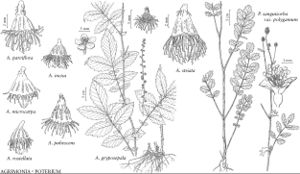Agrimonia rostellata
Beitr. Bot. 1: 42. 1842.
Herbs, 4–10 dm. Roots: tubers fusiform. Stems with glistening stipitate-glandular hairs and hirsute (hairs stiff, sparse to scattered, erect, 1–2 mm). Leaves: mid cauline stipules ± falcate to ± 1/2-ovate, margins often deeply incised; major leaflets 3–11 (mid cauline 5–7), minor 0–1 (–2) pairs; major leaflet blades obovate to broadly elliptic to elliptic, terminal largest, largest of these 3.4–10.5 × 1.7–5.6 cm, margins serrate, apex acute to obtuse, abaxial surface glistening with sessile-glandular hairs (often shining) and hirsute (hairs sparse to scattered, 1 mm). Inflorescences: axes glistening with sessile-glandular hairs and ± ascending-hirsute (hairs stiff, sparse to scattered, 0.5–1 mm). Flowers ± alternate. Fruiting hypanthia hemispheric, 1–3.1 × 1.8–3.9 mm, obscurely sulcate, hooked bristles in 2–3 circumferential rows, proximal row spreading to ± 90°, usually glistening with sessile-glandular hairs.
Phenology: Flowering Jul–mid Sep.
Habitat: Edges, open spaces, and thickets, deciduous or mixed deciduous woods
Elevation: 0–1100 m
Distribution

Ala., Ark., Conn., Del., D.C., Fla., Ga., Ill., Ind., Kans., Ky., La., Md., Mich., Miss., Mo., N.J., N.Y., N.C., Ohio, Okla., Pa., S.C., Tenn., Tex., Va., W.Va., Wis.
Discussion
Selected References
None.
Lower Taxa
"thin" is not a number.
